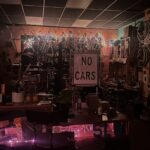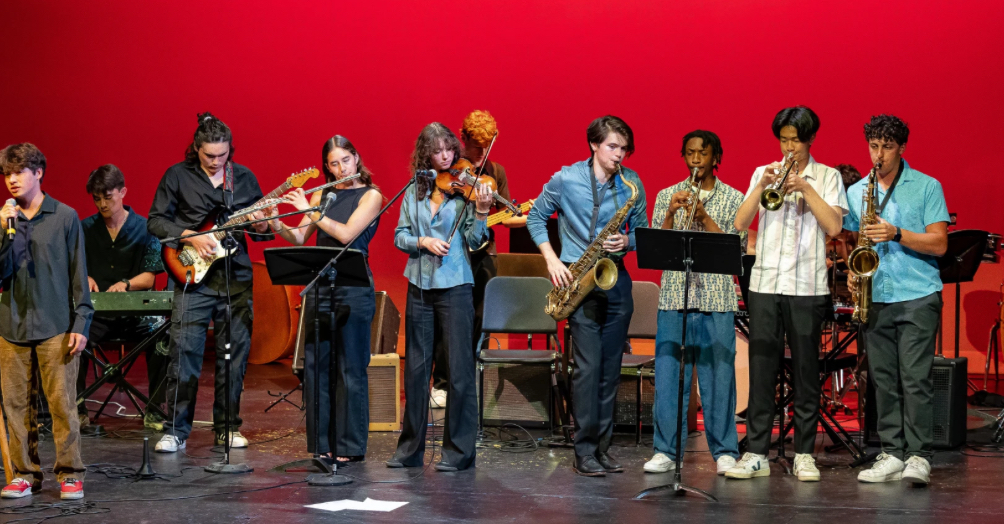
Lick-Wilmerding High School’s hidden gem lies tucked away in an alcove behind the cafeteria, and you might be able to hear them casually reincarnate a piece of musical history: the instrumental music program, a beacon of evolving culture at LWHS. As classical and jazz music diminuendo into obscurity, the jazz and orchestra classes serve to educate the greater community on the keystone purpose that instrumental music serves in today’s world.
Music at LWHS has proved to be an opportunity for intense collaboration, a fusion of subgenres from across centuries and a chance to give back to the local community. This fall, their cost-free concert is a pleasant bargain in comparison to the $81 SF symphony ticket.
In designing the program for the Jazz concert, Jason Gillenwater, instrumental music teacher at LWHS, focuses on bending the narrative of stereotypical jazz standards.
On Thursday, November 21, the Chamber Orchestra and Vocal Ensemble fall concert kicked off the 2024-2025 instrumental music season. The highlights included a collaboration between the Chamber Orchestra, Vocal Ensemble and Advanced Jazz classes. The choice of a Stevie Wonder hit as the grand finale was unexpected proceeding a lineup of Mozart and Chopin, however the audience was invigorated with an upbeat energy.
“During ‘Isn’t She Lovely?’ I was really hyped and I was singing along!” Camille Williams ’26 said. “I loved the variations in ranges and types of music they played… It was a really magical night,” Barbara Messing, parent of Vocal Ensemble student Caroline Waingortin ’27, said. Four attendees agreed that they’d strongly encourage the LWHS community members who were absent to support the program in the future. “The audience is usually sparse,” Cerys Cherny ’26, a clarinet player in the Chamber Orchestra, said. “It’d be more exciting if it were a full theater.”
They performed a familiar Laufey cover, and students were kept on their toes, playing a piece with an unorthodox 11/8 time signature. Arman Agbabian ’27 has played both trumpet and piano in Orchestra. “People think classical music is an old German guy in a wig writing music in the 1700s; very boring and slow music,” he said. “We need to educate the new generation to unlearn these biases and explore other genres of classical music.”
An imperative part of this education comes in the form of exposure through accessible concerts. To Agbabian, agency in the course curriculum is essential. “Mr. Gillenwater lets us choose which pieces to do, and he lets us self-conduct. It teaches us to collaborate and be independent with our musicality,” he said.
A nontraditional class like this allows for peer bonding in such highly codependent groups—a jigsaw puzzle where each player is an essential piece of the whole. Students experiment with combinations of instruments and group sizes, from 4-hand piano duets to string quartets to the entire class, not to mention the assortment of musical abilities available that year.
Finding arrangements for such a unique combination of instruments has caused the students to reckon with their historical uses and ensembles. “The trumpet has been used to announce royalty, but it’s also been used to play blues and jazz,” Agbabian said, who has toed the line between these genres. On the trumpet, he played a duet with a tuba. Along the same time frame, he worked on a piano piece where he accompanied a violin.
In addition to our own student body, the music these classes create inspire a younger audience. “When I was in eighth grade as a prospective student, I went to a Lick jazz concert with my dad to check it out. They played a song by a band called ‘Snarky Puppy,’ kind of like modern jazz—it was different from all the other stuff they did, and really spoke to me. I later learned that the song was student-picked and I thought, ‘maybe I can really have an influence on what I play,’” Coleton Namie ’27, a Jazz Band student, said.
Other opportunities have arisen for the bands to reach a broader audience. With as much professionality as a full-time adult band, the LWHS Advanced Jazz ensemble has played at major San Francisco events from a Chinatown block party to a black-tie affair at the Fairmont Hotel. However, there’s one thing they do differently from the professionals: they donate all show proceeds to the Homeless Prenatal Program. This isn’t the only form of public purpose work they do. Once a semester, each class packs cost-free groceries for Homeless Prenatal Program customers. At every semi-annual concert, “[entry] is free because the attendees are asked to donate to the Homeless Prenatal Program instead,” Jen Belenson, parent of Avery Belenson ’27 and spectator of the Chamber Orchestra concert, said.
Conservatories across the world are experiencing a decline in the public’s attendance. In 2017, 8.6% of US adults attended a classical music concert. Five years later, in 2022, this statistic almost halved—4.6%. This decline worsens today, even as Americans are spending more money on live entertainment post-COVID according to Marketplace.org.
Jazz too has been considered “America’s only true art form” by many, including Moira McLaughlin, an art and history expert at the Washington Post. It has evolved with the invention of records, telling a history of not only the technology with which we listen to music, but also of Black resistance and the complicated desegregation that took place through much of the 20th century. Genres that reign currently, including Rock, R&B, Hip-hop and Pop are heavily rooted in jazz. Yet, its popularity has been steadily declining since the death of its most influential faces like Louis Armstrong. In 2021, this genre represented only 0.8% of all songs streamed in the U.S, and was the least-streamed genre. “America’s only true art form” is clearly on the endangered species list.
Such a scarcity affects more than avid listeners; it impacts massive organizations and conservatories that were founded with the sole purpose to revive dying arts through performance and education. At the San Francisco Symphony, severe budget cuts were recently implemented. “[We must] make sure that by the end of the year we still have a reasonable amount of money to move forward,” Priscilla Geeslin, Board Chair of the SF Symphony, said. Dwindling attendance is the primary cause of its financial struggles: “Our challenge is not an internal one, [it] is an external one,” Matthew Spivey, the Executive Board Director at SF Symphony, said.
Through the lens of the recent city elections, there may be a light at the end of this tunnel. In San Francisco, the recently initiated Prop A budgets $790 million for new infrastructure in the SF Unified School District (SFUSD), including for new theaters and arts education spaces. If Prop A causes the SFUSD to place more emphasis on their music curriculum, this could mean a new generation of avid classical concert-goers.
Returning to the lens of LWHS, providing accessible music to the public and inciting flexibility in the status quo of music is just the beginning of a generation of arts advocacy.







